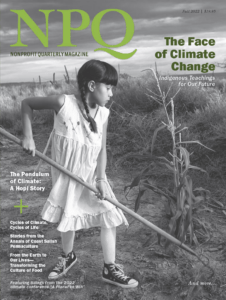
The following Voices from the Field comes from the author’s new book, Social Innovation: How Societies Find the Power to Change. We excerpt it here because we find it thought provoking. We’d love to see comments from readers on this one.
There are very few thinkers who have changed how we see the world, and even fewer who have changed how we think about how we see the world. Mary Douglas was one of the very rare exceptions. Her field was culture, but she was as unlike the stereotypical cultural academic as one could imagine. A devout Catholic whose late husband was head of research at Conservative Central Office, she used the decades after she passed retirement age in an extraordinary flowering of enquiry that provided striking insights in fields as diverse as the study of the Old Testament and the politics of climate change.
She was a rare example of a public intellectual whose theoretical apparatus allowed her to think in original ways about almost any topic—for example, in her ideas on enclaves, the small groups which at their most extreme become terrorist cells. Where others emphasize their strengths, she emphasized their weaknesses: how prone they are to splits and sectarianism, and how hard it is for their founders to impose and enforce rules. To survive, they create around themselves what she called a ‘wall of virtue’—the sense that they alone uphold justice, while all around them are suspect. Yet the very thing that binds them together encourages individuals to compete to demonstrate their own virtue and the failings of their peers. The only thing that can override this fragility is fear of the outside world—and so sects, whether political or religious, peaceful or violent, feed off the fear and hostility of states and societies, using it to reinforce their own solidarity and their own sense of virtue. The implication is clear, and challenging, for Western governments: in the long term, defeating terrorism depends on ratcheting fear down, not up, and on dismantling the “walls of virtue” rather than attacking them head on with declarations of war.
This example is just one of many from a varied and fertile career that took Douglas from field work in the Congo to nuclear power. She was a “genius of lateral thinking,” in the words of another anthropologist, Adam Kuper. Her work was, however, shaped by a common thread: an interest in how societies shape the way people see the world, and a radically anti-individualistic account of how human cultures really work, in which people are better understood as bearers of the world-views of their institutions and cultures than the other way around.
Douglas’s classic Purity and Danger1 (ranked by the Times Literary Supplement as one of the 100 most influential books in the West since 1945), for example, showed how societies respond to the threatening nature of ambiguities with taboos and proscriptions—whether of foods or behaviors. Another strand of her work looked at the world of goods and showed how we use consumption to send messages to each other. An even more influential stream of books took on the question of risk—and showed how apparently irrational attitudes to nuclear power or genetically modified crops reflect deeper beliefs about what sort of society we want to live in, and which kinds of institutions we trust.
In each of these fields Douglas’s work set in motion new schools of thought. Perhaps the most fertile of all of these is now being used to make sense of why so many well-intentioned policies fail, and why some others succeed even though they appear to work less well on paper. Her starting point is a deceptively simple framework which she repeatedly used to make sense of organizations and societies. It is a framework which should be part of the mental furniture of any educated person, as basic as the laws of supply and demand in economics, or the laws of thermodynamics.
Any culture, she argues, can be mapped on two dimensions. On one axis is what she calls the “grid”—the extent to which behaviors and rules are defined and differentiated, for example by public rules deciding who can do what according to their age, race, gender or qualifications. Examples of a high grid would be a traditional corporation, a traditional agrarian society or families with clear demarcations of roles and times (when to eat, when to go to bed). On the other axis is what she calls “group”—the extent to which people bond with each other and divide the world into insiders and outsiders. The more people do with a group of other people, the more they experience testing trials, or the more difficult the group is to get into, the higher the sense of group belonging will be.
These two dimensions come together to provide a simple two-by-two matrix: high grid and high group mean hierarchy; low grid and low group mean individualism; high group and low grid lead to egalitarianism; and low group and high grid result in fatalism. This very simple model has turned out to be a powerful tool for understanding social relations and for making sense of how people see the world. We may like to believe that we choose and shape our own beliefs, but Douglas, drawing on the work of Émile Durkheim and others, suggests that it’s much easier to understand societies by turning that assumption on its head: societies and institutions think through us much more than the other way around.
Within a hierarchical culture the world is seen as controllable so long as the right structures and rules are in place. Most governments tend towards hierarchy. It is the natural world-view of civil servants, political leaders and most of the consultants working in and around big business and governments. To every problem there is a solution—so long as it is firmly enough implemented by a sufficiently powerful leader or elite team.
In an egalitarian world-view, the problems usually arise from too much hierarchy and inequality, and not enough bonding and solidarity. More discussion with more people is seen as an unmitigated good, and any measures which widen inequalities are to be resisted. In an individualistic world-view the answer to problems is more freedom—let people determine their own choices, and things will come right. Dissent is to be celebrated; rebels are heroes; and the world is made, and remade, by the imagination and energy of individuals. The fatalistic worldview is most common among people with little power and little experience of power.
What is striking about these four world-views is that they can be found at every level of human organization—from families and streets to global companies and the United Nations (UN). They are constantly in tension with each other, merging and combining in new ways. Indeed, they need each other. Hierarchies need to re-energize themselves with the creativity of passionate individuals, and some egalitarianism, to reinforce their sense of common purpose. Egalitarian cultures need some hierarchy to resolve disputes and make decisions. Individualist cultures need some hierarchy to enforce the rules, and some egalitarianism to encourage people to care for each other. All, perhaps, need some fatalism to get by and to avoid a constant state of rebellion.
Sign up for our free newsletters
Subscribe to NPQ's newsletters to have our top stories delivered directly to your inbox.
By signing up, you agree to our privacy policy and terms of use, and to receive messages from NPQ and our partners.
In their book applying Douglas’s ideas to the world of public policy, Clumsy Solutions for a Complex World,2 Michael Thompson and Marco Verweij use the example of climate change to show how these different perspectives can shape a strategic argument. For egalitarians, climate change is a consequence of the profligacy of the rich North. A rapacious capitalist system has led to widening inequalities and the destruction of our shared environment. The flaws of big government and big business have wrecked the world. The solutions therefore lie in a return to smaller-scale institutions, which are closer to nature and free from gross inequalities, and a return to a simpler and more sustainable life-style.
From a hierarchical perspective climate change is a problem that can be solved only with a new hierarchy. Climate change is the result of millions of individual decisions that make sense in isolation but that together risk destroying a common resource. The world now needs strong rules and strong enforcement to cut CO2 emissions. That will mean binding treaties that go well beyond Paris; new organizations—perhaps a World Environment Organization—to enforce them; and equivalent laws and regulations across nations. Scientific knowledge, collected by the Intergovernmental Panel on Climate Change, has provided the world with an authoritative truth about the climate that now needs to be taken seriously.
From an individualist perspective, both of the other groups are scaremongers, using unproven science to impose unnecessary burdens on the world. Past experiences show that, given the freedom to do so, people and markets are sufficiently adaptive to avoid disaster. New technologies will arise from competition to cut emissions, if that is what is needed, and in any case the solutions proposed by others are likely to be worse than the problem they are seeking to address. For the fatalists, we are simply all doomed. All four stories are plausible; all are strongly held by different groups; and all are resistant to disproof by any new evidence.
The same patterns can be found in relation to migration. For individualists, immigration is a good thing: there should be as much mobility of labor as possible. Given the freedom to do so, migrants will contribute to their new society and overcome any barriers. For egalitarians too, migration can be a good thing, but needs to be supported by strong rules against discrimination. For hierarchists, however, migration is more likely to be seen as disruptive and needs to be accompanied by active social engineering to ensure that migrants are properly socialized and integrated.
Rationalists like to believe that policy battles end with one side winning. But in practice this rarely happens and, when it does, it causes more harm than good. Hubristic hierarchy—in the form of planning—was repeatedly discredited in the 20th century, just as hubristic neoliberal faith in markets has been discredited in more recent decades and extreme egalitarianism was undermined by the anarchic experiences of revolutions in full swing. Many of us learn in life that overly neat and rational solutions don’t work in practice, and Douglas would argue that the best institutions and the best societies achieve a rough and ready balance between different cultures. Their inconsistency is what makes them work. This is perhaps not a new insight. But it is surprisingly rare to find it in any discussions of public policy, which tend to implicitly rely on one or other cultural lens.
Yet, as Michael Thompson and his collaborators have shown, the most successful policies and strategies tend to draw on many cultural models at the same time: they combine expert analysis and design with widespread deliberation and partnership between many players, along with markets and other arrangements that tap into individual motivations. The World Wide Web is an outstanding example which has fed off all of these, even if the internet was originally imagined as a decentralized complement to the command and control system for the US military. The Kyoto Protocol of 1997 was an example of relying on just the single top-down bureaucratic regulation of activities—but without much realistic prospect of implementation, let alone effective monitoring (the Paris Agreement of 2015 was subtler in its tools). In practice, combating climate change will depend on the interaction of many cultures; some regulations and penalties, combined with market forces, favoring energy efficiency and renewables; and egalitarian cultures driving people to adopt more sustainable life-styles and to take responsibility for the future of the group—in this case humanity.
How should we use these insights? They cannot be translated into a precise method, a reliable set of tools which can be applied to any situation. Indeed, these insights are warnings against using any one set of tools as the definitive answer to such complex things as human society. But they are very powerful tools for thinking about any strategy to change the world, and any attempt to achieve social change. Bluntly, if it doesn’t contain some room for all of the cultural frames, then it will likely fail. So, for example, public service reforms based only on incentives are as doomed to failure as strategies to cut antisocial behavior that rely only on coercion. The purist visions of wholly egalitarian structures using the blockchain, or platform cooperatives, are as unlikely to thrive as their purely authoritarian equivalents.
Douglas’s work is a healthy antidote to the simplistic versions of “solutionism” which promise to rain down solutions onto grateful populations. It’s also a healthy reminder that meanings and feelings matter as much as rational analysis and evidence: how people make sense of an idea may be as important as the idea itself.3
Perhaps more troubling, however, are the implications of her work for the future. In more fractured societies, with weaker families and hierarchies, there are bound to be more isolates, more people detached from groups and hierarchies, who will be seeking meaning in enclaves. Some may be content to take refuge behind a wall of virtue. But others will take up arms.
Mary Douglas’s biggest insight is perhaps a warning against depending too much on rational argument. How we see the world depends as much on where we sit as on what we think, and human beings in whatever stage of development can often be understood better through their rituals and behaviors than through their doctrines and beliefs.
Notes
- Douglas (1966) Purity and Danger, London: Routledge.
- Thompson and M. Verweij (2006) Clumsy Solutions for a Complex World, Basingstoke: Palgrave Macmillan.
- A good overview of Douglas’s work can be found in P. 6 and P. Richards (2017) Mary Douglas: Understanding Social Thought and Conflict, New York: Berghahn Books.












